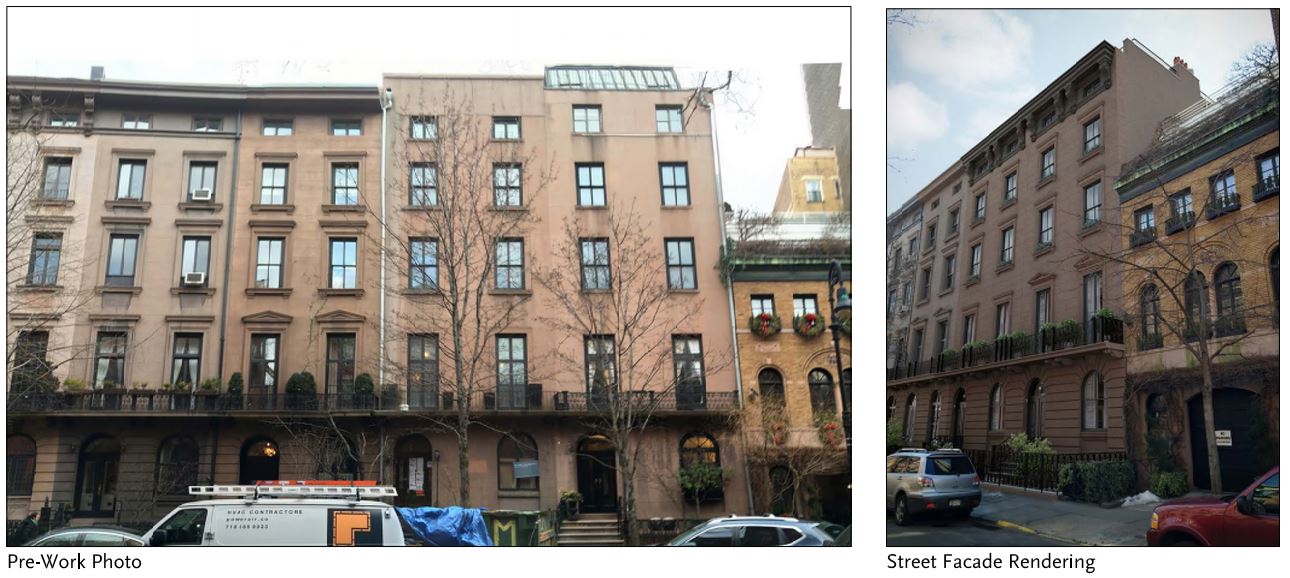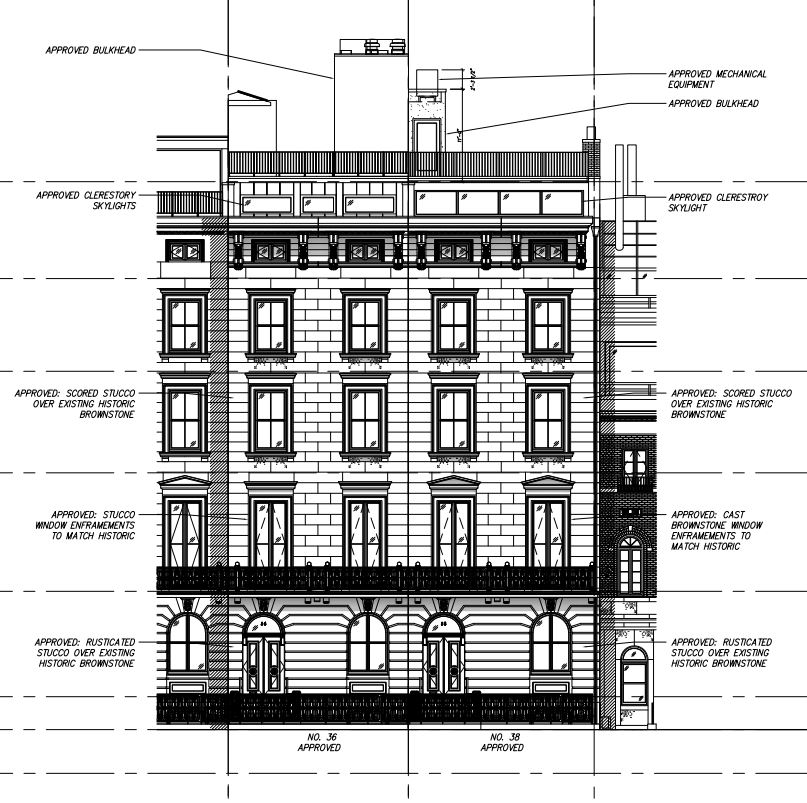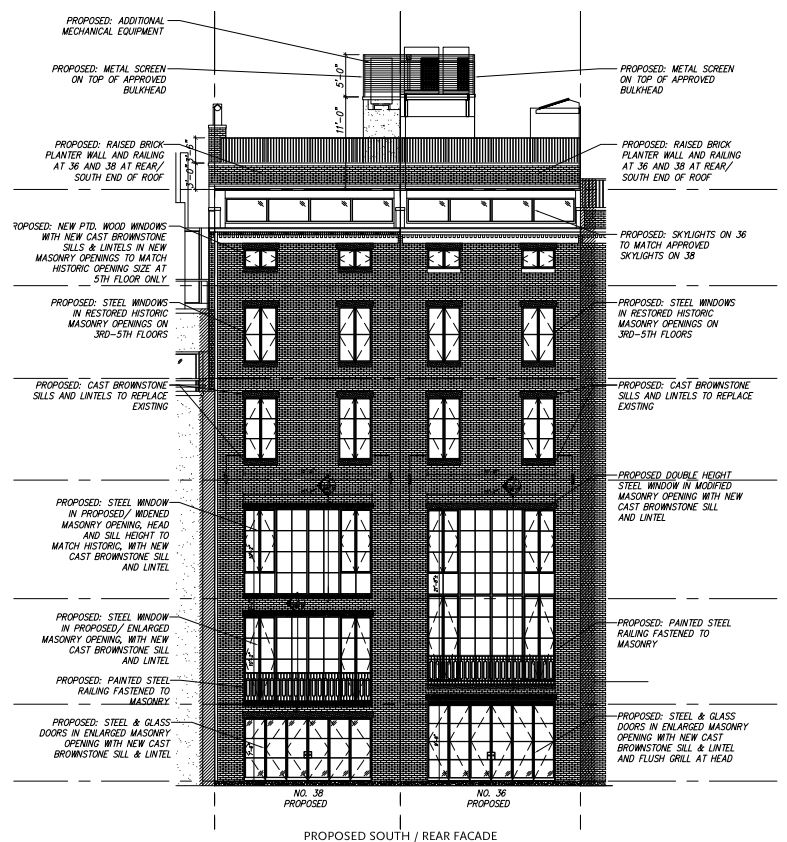A new proposal to merge and renovate 36 and 38 West 10th Street is set to be reviewed by the LPC today. Located along West 10th street between 5th Avenue and 6th Avenue in Greenwich Village, the project is composed of two five-story brownstones, each with six units apiece, which will be turned into a single mansion. The revisions are being carried out by John Ike of Ike Kligerman Barkley Architects. The developer of the project is Tom Van Loben Sels.
Plans call for the 8,976 square foot 38 West 10th Street to merge with its neighbor, of a similar scope. An overhaul of the northern facades along West 10th Street would come with a new darker rusticated cast brownstone to match the surrounding context and adjacent buildings. Other proposed plans include new window sill planters for each window, brownstone enframnents to match the new facade, clerestory skylights, a deep and dark colored cornice line above the fifth floor, and proposed metal bulkheads and mechanical equipment placed in the center of the roof to prevent them from being seen from the sidewalk.
Much of the original veneer ties holding up the old and deteriorating brownstone facade and structural walls have worn away over time. They will be fully replaced with new metal ties that will hold up the new four-inch deep cast stones. On the southern facade, all the windows would be replaced with new steel and glass frames. Each would be accompanied with cast brownstone sills and lintels. Painted steel rails would come attached and fastened to the new masonry facade on the second-floor windows above the backyard patio. Identical skylights are proposed on both 36 and 38 West 10th Street, sitting under a raised back planter wall for the new roof line of both brownstones. The buildings would be topped off with new bulkheads and mechanical equipment covered with metal screens.
The LPC will review the proposal later today.
Subscribe to YIMBY’s daily e-mail
Follow YIMBYgram for real-time photo updates
Like YIMBY on Facebook
Follow YIMBY’s Twitter for the latest in YIMBYnews









Please pardon me for using your space: Gentility from me on your developments show when I get it with evidence. (Thanks to Michael Young)
The true stranglehold on NYC is the Real Estate Board of New York and the corrupting influence it pedals within our political system. Without the efforts of the preservation community, there would be no reason for any visitor to want to come to NYC.
Agreed. Too many historic buildings continue to be destroyed when at least keeping the facade would be possible. Removing the oldest building along any given block should be nearly impossible.
“Stranglehold?” Really? It’s in a Landmark District, so yes of course the LPC has jurisdiction over alterations. Do you at YIMBY understand that it is the desirable qualities that make this a landmark district that gives real estate within the district it’s absurdly high value. People want to live there because of landmarking, not despite it. Could you have used a word less intentionally inflammatory than “stranglehold?”
Do you understand that absurdly high real estate values without zoning that matches transit infrastructure is a waste of public $ and essentially a free subsidy for the highest-income New Yorkers? Because that’s what this is, and it is entirely due to LPC’s stranglehold on GV.
GV wasn’t always a high income neighborhood, it also used to be much more densely populated as well. This has changed as the historic houses that were sub-divided into studios and 1-bedrooms have been steadilty converted into single family residences, often with a loss of 75% or more of the former number of persons living there. The neighborhood is much changed from 30-40 years ago, when it was higher density and a more mixed-income demographic.
Thank God for the LPC otherwise the Yimby’s would gladly see NYC’s historic districts flattened to make way for rows of endless highrise glass boxes. The reasoning? Just because they are near transit lines, they should be upzoned and bulldozed to increase the density tenfold.? The same transit lines that run through GV also run to the Bronx and Brooklyn and Queens so nobody is getting a free subsidized ride but of course let’s bash the evil 1% again for all the world’s woes.
They are only historic districts because some people call them as such. In 100 years, or 500 years, they will be obliterated regardless. “Historic preservation” is a contemporary phenomenon of the narcissism epidemic whereby some people think that deeming something to be permanent will make it so — this is not the case, and a complete fallacy that only serves to displace low-income individuals and reduce efficiency of the city. Development incorporating old buildings should be incentivized but the notion that enacting laws will actually grant permanence amidst wars and climate change (two constants in human history) is absurd.
Thank you for clarifying your views, good to know that everything should be torn down for “more housing”. That GV adds value to the entire city as a tourist attaction and as a popular place for city residents to spend their time isn’t as important as building glass boxes for the 1%.
In fact, it is not only landmark buildings that are “permanent”, all of the whitebrick 50’s and 60’s coops and 70’s crappy condos are also permanent, in that they are owed by many individuals and are therefore practically impossible to tear down unless 75% of owners consent to it.
Finally, all those historic european towns and villiages that have been around for 500+ years, are all of those people who live there Narcissists for not wanting their homes destroyed and replaced with apartments?
If you want to mandate that new buildings in GV use contextual style and must submit to design review for density increase, that would be acceptable to me. I would also support bonuses for incorporating (worthy) old facades.
I do not think that European towns that have existed for 500+ years are full of narcissists, however, the notion that this kind of typology is all that prevalent in Europe is incorrect. Are there towns with 500+ year old buildings? Yes. But major cities feature much less history in general due to past waves of displacement in the countryside / urbanization, and war. Paris is literally younger than most of Greenwich Village!
I noticed the word “stranglehold” in the headline yesterday and was surprised upon reading the article to see that that “stranglehold” characterization was used simply in regard to the LPC doing its actual job. That says a lot. It also makes one wonder why someone who feels this way about NYC wants to live here if what they really want are a modernistic cityscape of gleaming glass and steel towers. Not that these things don’t exist here, but still. Few people move to NYC because it is “efficient.”
Complaining about the privileged rich and the 1% is just a red herring – an attempt at claiming a social justice halo. That a building may not last another 100 or 500 years does not mean that we need to make the active decision to destroy it now.
There are already places in this country — especially in the Sun Belt — where there is little to no zoning and little to no historic preservation, so we don’t need to have this kind of experiment in NYC because we can already see the results of that policy choice in Houston, Dallas, Las Vegas, much of Florida, etc. My feeling is that if that’s one’s desired policy choice, one should move to one of those burgs.